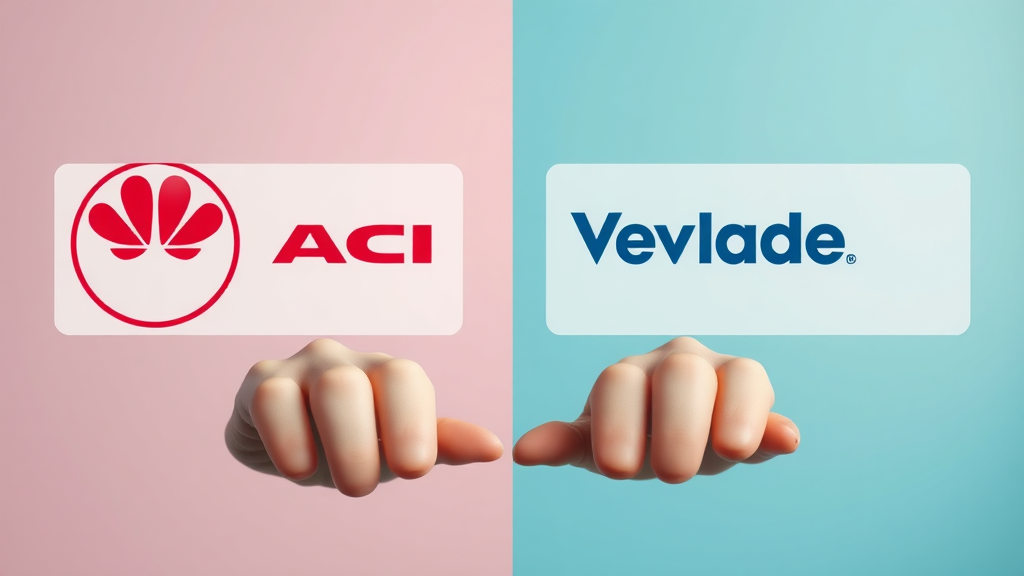Did you know: Consistent brand presentation across all platforms can increase revenue by up to 23%? In today's hyper-competitive marketplace, companies with a strong brand identity don't just stand out—they thrive. Dive into this comprehensive guide to discover the unconventional forces and creative strategies behind crafting a memorable, growth-driven brand identity. Whether you’re building a new brand or revitalizing an established one, mastering your brand’s identity will ensure you never look back.
Brand Identity: Startling Statistics and the Unconventional Power Behind a Strong Brand
Brand identity is more than just a logo or a catchy slogan; it's a strategic asset that propels business growth and elevates brand image. Recent research reveals that companies maintaining a consistent brand identity across all consumer touchpoints see a significant boost in financial performance—up to 23% more revenue, according to Forbes. But the benefits go deeper. A strong brand identity is a key element in building trust, fostering loyalty, and shaping a positive perception among your target audience. By unifying visual identity, brand voice, and messaging, brands of all sizes can differentiate themselves in crowded markets and create lasting connections.
Moreover, the unconventional power of a memorable brand goes beyond sales figures. It infuses meaning and confidence into every aspect of your business—from recruiting top talent to earning organic mentions on social media. The compounded impact of consistency in identity design, purposeful brand guidelines, and thoughtful storytelling can make the difference between being forgotten—or being the brand everyone talks about. Simply put, brand identity is a critical step in any winning brand strategy.

"Consistent brand presentation across all platforms increases revenue by up to 23%." — Forbes
What You’ll Learn About Brand Identity
- Understand the key elements of brand identity
- Explore best practices in brand identity design
- Discover how brand identity influences brand image, audience trust, and business growth
- Review visual identity components including color palette and logo
- Learn how brand guidelines maintain consistency
- Gain practical tips to build a strong brand identity
What is Brand Identity? The Cornerstone of a Strong Brand
Defining Brand Identity and Identity Design
Brand identity is the unique collection of all visual, verbal, and emotional components that a company creates to distinguish itself in the minds of consumers. It answers the critical question: how do you want your audience to perceive and remember your business? Effective identity design combines consistent logo design, strategic color palettes, distinctive typography, and a compelling brand voice. Together, these visual elements form a cohesive visual identity system, ensuring that your brand appears intentional, professional, and trustworthy.
Brand identity design goes deeper than the surface. It encapsulates not only the look and feel but also the underlying mission, vision, and values that guide a business. When executed well, it becomes a magnet for your target audience, communicates your unique selling proposition, and forges a relatable brand story. Every style guide, logo, and brand color is intentionally selected to reflect the essence of your business—making brand identity the key element of long-term success.

Brand Identity vs. Brand Image vs. Visual Identity
Brand identity refers to the intentionally crafted components a business uses—name, logo, color palette, typography—to shape public perception. In contrast, brand image is how that business is actually perceived by customers based on experiences and interactions. Meanwhile, visual identity is the visual aspect of brand identity—think logos, colors, typefaces, and graphics. All three work together to build a great brand: brand identity sets the blueprint, visual identity provides the visual language, and brand image is the real-world outcome.
Key Elements of a Strong Brand Identity
For a brand identity to be powerful and memorable, certain key elements must align seamlessly: a clearly defined brand persona, a recognizable logo, a balanced color palette, purposeful typography, and a consistent brand voice. Each supports your brand strategy, ensuring every interaction strengthens brand recognition and affinity. A memorable brand is rooted in authenticity—your visual identity and messaging should genuinely reflect your company’s values and mission. Ongoing attention to these brand elements is vital for building a brand that not only attracts but also retains your ideal audience.
Remember, your brand guidelines act as the anchor for these elements, maintaining visual and verbal consistency across all platforms, from your website to social media to print materials. By solidifying the core of your strong brand identity, you foster trust, encourage customer loyalty, and elevate your brand image.
As you refine your brand identity, it's also important to consider how your efforts translate into real-world visibility. For actionable strategies to rapidly increase your brand’s reach, explore these proven methods to boost brand awareness fast and ensure your identity gets noticed by the right audience.
The Importance of Brand Identity in Brand Strategy
Why a Strong Brand Identity Matters
Building a strong brand identity isn’t just about aesthetics—it’s a fundamental aspect of a winning brand strategy. A unified identity design serves as both a differentiator and a trust-builder, helping your business stand out in a competitive market. When your brand’s messaging and visual identity are tightly integrated, customers are more likely to remember, trust, and recommend your business.
A great brand’s identity also provides direction for marketing campaigns, product development, and even company culture. By aligning all team members and stakeholders around consistent brand guidelines, you create a solid foundation for innovation and growth. Your brand story becomes believable, relatable, and valuable, driving long-term loyalty and improving customer lifetime value.

The Role of Brand Identity in Brand Guidelines and Growth
Brand guidelines are the bedrock of scalable brand growth. They provide a clear framework for how your identity design should manifest across channels and time. More than a style guide, brand guidelines codify your visual identity (logos, color palettes, typography) and verbal identity (brand voice, messaging), ensuring every element aligns with your core values and mission.
As your company grows, these brand guidelines become critical for onboarding new staff, briefing agencies, and maintaining a consistent brand personality. They prevent dilution of your brand identity, enabling you to successfully expand into new markets, roll out new products or services, and adapt to changing trends without losing sight of your authentic brand story.
"A brand is no longer what we tell the consumer it is — it is what consumers tell each other it is." — Scott Cook
Successful Brand Example: How Great Brand Identity Drives Success
Understanding the mechanics of a successful brand is crucial when building your own. Brands like Apple, Nike, and Coca-Cola have soared to the top not only because of their products but because of their unwavering brand identity design. Each brand’s visual presence is instantly recognizable, underpinned by rigorous brand guidelines and a distinctive brand voice. Their carefully chosen color palette, typography, and logo design reinforce brand image and foster emotional connections with millions worldwide.
These powerhouses are proof that investing in your brand identity can propel your business from commodity to cultural icon. Examine their identity design choices; you’ll see the harmony between authentic storytelling and innovative visual language—making each interaction more meaningful and memorable.
| Brand | Visual Identity | Color Palette | Brand Voice |
|---|---|---|---|
| Apple | Minimalist logo, clean lines, crisp imagery | White, black, silver, space gray | Innovative, friendly, sophisticated |
| Nike | Iconic swoosh, bold graphics | Black, white, orange/red | Inspirational, motivating, empowering |
| Coca-Cola | Script logo, classic shape, dynamic curves | Red, white | Optimistic, joyful, welcoming |
Case Study: A Strong Brand with Consistent Identity Design
Consider the difference between FedEx and a lesser-known delivery brand. FedEx’s standout identity design—from its iconic logo and carefully selected brand colors to its unmistakable brand voice—creates instant trust and recognition. Every package, vehicle, and advertisement reaffirms its promise of reliability and speed. The result? Customers choose FedEx not just for logistics, but because of the powerful, reassuring brand image built over years of consistent application.
In contrast, brands with a weak or inconsistent identity struggle to foster loyalty or command premium positioning. Consistency in visual identity, storytelling, and messaging—anchored by well-crafted brand guidelines—creates a resilient, successful brand that grows stronger with every customer touch point.

Essential Elements of Brand Identity Design
Visual Identity: Logos, Typography, and Color Palette
The first step in brand identity design is creating a powerful visual identity. This includes a well-designed logo, balanced color palette, and consistent typography. Your logo acts as a visual handshake, making an immediate impression and reinforcing your brand’s promise. Careful selection of brand colors conveys emotion and influences how customers perceive your brand—think blue for trust, red for excitement, green for growth.
Typography also plays a crucial role in expressing your brand’s personality. Consider how Apple’s sleek sans-serif font communicates modernity and innovation, or how Coca-Cola’s flowing script invokes nostalgia. By creating a consistent visual identity across all touchpoints, you harness the full power of identity design to shape brand image and foster long-term recognition.

- Memorable logo design
- Core color palette (primary, secondary, accent colors)
- Typography system (headings, body, accent fonts)
- Consistent graphic and icon style
- Photographic and illustration style guidelines
- Clear visual hierarchy and layout rules
Brand Voice and Brand Persona
A brand voice is how your business “sounds” in both messaging and communication style. It should reflect your unique brand persona—the personality and character of your brand. Is your tone formal, playful, expert, or conversational? Choices here impact how your messaging is received, ensuring your brand is relatable to your target audience. Establishing guidelines for vocabulary, tone, and message construction cements your identity in the minds of your audience.
Alongside voice, your brand persona brings consistency to every customer interaction. Whether you’re responding to a customer inquiry or launching a product, maintaining a coherent personality and set of values strengthens your overall brand identity.
Crafting Your Brand Story
A compelling brand story is the emotional thread that connects your brand with its audience. It goes beyond products or services to explain your mission, purpose, and journey. Effective storytelling not only reinforces the values behind your brand but also invites customers to become part of your narrative. When consumers see themselves reflected in your story, trust and brand loyalty follow.
To craft a great brand story, focus on why you started, what you stand for, and how your brand impacts customers’ lives. Bring this story to every touchpoint—your website, marketing materials, and social media—to create a unified, authentic identity.

Step-by-Step Guide: How to Build a Brand Identity
Step 1: Define Your Target Audience
The foundation of effective brand identity is understanding your target audience. Who are they, what are their needs, and how can your brand solve their problems? Develop detailed user personas to represent your ideal customers—their demographics, behaviors, motivations, and challenges. This research shapes every decision, from color palette to brand voice, ensuring your brand identity resonates authentically.
By tailoring your brand strategy to align with your target audience, you increase relevance, boost engagement, and lay the groundwork for a consistent and successful brand image.

Step 2: Outline Your Brand's Mission, Vision, and Values
Next, clearly articulate your brand’s mission (what you do), vision (the future you aspire to), and values (core beliefs driving your actions). This step is a key element in identity design, setting the tone for your brand persona and all subsequent decisions. Strong brands consistently express these foundational pillars in both messaging and practice—showing audiences that your company stands for something beyond profit.
Documenting your mission, vision, and values anchors your brand strategy. It also serves as a guiding framework for employees, helping internal teams deliver a unified brand experience at every touchpoint.
Step 3: Develop Your Brand Persona and Brand Story
With your audience and core principles defined, shape your brand persona to reflect traits and characteristics meaningful to your customers. This is where your brand story comes alive. Use narratives that demonstrate challenges overcome, values fulfilled, or moments of inspiration. A relatable and authentic brand persona—brought to life through intentional storytelling—deepens emotional bonds and fosters allegiance to your brand.
Review top brands and you’ll notice the strength of their persona and storytelling. Whether you’re edgy and disruptive or warm and approachable, ensure your story is consistent, honest, and woven throughout every aspect of your communication.
Step 4: Design Your Visual Identity – Key Elements
This step involves selecting the right logo, developing a cohesive color palette, establishing a typography system, and choosing supporting visual elements—all drawn from your brand strategy and persona work. Collaborate with expert designers to ensure each visual asset aligns with your intended brand image. Test your visual identity across platforms, ensuring versatility, clarity, and appeal for your target audience.
Remember to create a style guide that captures these decisions, providing clear instructions for consistent use in marketing, packaging, and digital experiences.
Step 5: Create Brand Guidelines for Consistency
Brand guidelines are your playbook for preserving and growing a strong brand identity. Document logo usage, color scheme, typography, brand voice, and photographic style. Set rules for everything—from minimum logo sizes to proper language and tone on social media. These guidelines are essential for ensuring all teams, vendors, and agency partners present your brand faithfully, regardless of platform or region.
Consistent adherence to brand guidelines reduces confusion, strengthens customer trust, and boosts the long-term value and recognition of your brand.
Brand Identity Design: Choosing Your Color Palette & Typography
The Impact of Color Palette Choices on Brand Image
Your color palette is more than a cosmetic choice; it's a psychological trigger that can instantly communicate mood and values. Warm colors like red and orange can evoke excitement and energy, while cool hues like blue and green suggest trustworthiness and calm. Research consistently shows that up to 85% of consumers cite color as the primary reason for choosing a product. That's why aligning your color palette with your brand values and target audience is crucial to shaping a recognizable brand image.

Typography’s Role in Visual Identity
Typography communicates far more than words. Fonts influence perception, convey personality, and reinforce your brand voice—whether that’s playful, modern, elegant, or authoritative. The deliberate selection of serif, sans-serif, or decorative typefaces in headings, subheads, and body copy establishes visual hierarchy and brand consistency.
A memorable typography system, used consistently in web, print, and social media, ensures seamless recognition—even before your audience reads a word. That’s why it’s a foundational piece of any visual identity system.

Examples of Successful Brand Identity Design Decisions
Take Google’s playful primary color logo or Tiffany & Co.’s signature robin’s-egg blue box—these choices are no accident. Each is a product of strategic decisions in brand identity design, where visual identity assets are selected to maximize memorability and emotional resonance. Their success isn’t just in the individual elements, but in the way all assets combine to create a unified customer experience.
When building a brand, review how your visuals perform in a competitive landscape. Consistency and originality in color, typography, and iconography will elevate your message and secure your place as a memorable and strong brand in your market.
Brand Guidelines: Protecting and Growing Your Strong Brand Identity
What Are Brand Guidelines?
Brand guidelines—sometimes called a style guide—are the comprehensive set of rules that define how your brand should be visually and verbally represented. They specify logo usage, acceptable colors and typefaces, imagery style, brand tone, and more. By ensuring that everyone “presents your brand” consistently, brand guidelines help protect your hard-won brand equity and reduce confusion among internal teams and external partners.
How Brand Guidelines Foster a Strong and Consistent Brand
Consistency is a key element of building trust and recognition. When brand guidelines are followed diligently, your brand appears more professional, dependable, and easily remembered by your target audience. These guidelines also enable efficient scaling—new product launches, campaigns, and partnerships can adhere to brand standards, preserving your unique voice and visual style at every touchpoint.
As markets and media evolve, strong brand guidelines make it easy to refresh or adapt your identity without undermining your core promise. Invest in robust guidelines to secure your brand’s growth and reputation.
Brand Identity and Social Media: Amplifying Your Brand Voice
Leveraging Social Media to Strengthen Brand Identity
Social media platforms offer a powerful stage for amplifying your brand voice and reinforcing brand identity. Through consistent imagery, colors, and tone, brands can foster instant recognition and emotional connections with their community. Businesses leveraging a defined social media strategy see better engagement, higher brand recall, and greater influence over brand image among a global audience.
Responding promptly and authentically to comments, using branded visuals, and storytelling through posts all contribute to a memorable brand. Every tweet, story, or post is an opportunity to strengthen your visual language and share your brand story on an intimate, real-time level.

Best Practices for Brand Consistency Across Channels
Consistent application of visual identity and messaging across all social media and digital platforms is essential for building a strong brand image. Here’s how:
- Use your brand’s logo and color palette on all profiles and posts
- Maintain a unified tone of voice across captions, replies, and stories
- Employ branded templates for graphics and videos
- Coordinate messaging with campaign goals and broader brand strategy
- Regularly audit your content for alignment with brand guidelines
Building a Brand Identity: Key Element Checklist
- Define your target audience and unique selling proposition
- Establish your brand mission, vision, and core values
- Craft a distinct brand persona and detailed brand story
- Develop an integrated visual identity (logo, color palette, typography)
- Document and enforce brand guidelines for all uses
- Consistently apply your identity across web, print, and social media
- Monitor brand perception and adapt when needed
People Also Ask: Brand Identity – In-depth Answers
What is the brand identity?
Answer: Brand identity is the collection of all elements that a company creates to portray the right image to its audience, including name, logo, visual style, messaging, and behaviors that shape public perception.
What are the 5 pillars of brand identity?
Answer: The five pillars are purpose, positioning, personality, promise, and values; each is a key element in defining and maintaining a strong brand identity.
What are the 5 main brand personalities?
Answer: The five personalities are sincerity, excitement, competence, sophistication, and ruggedness, all helping tailor identity design to target audiences.
How to make brand identity?
Answer: Define your brand’s mission, research your audience, craft a unique brand story, develop visual identity (logo, color palette, typography), and create brand guidelines to maintain consistency.
Brand Identity FAQs: Your Top Questions Answered
How does a company maintain a strong brand identity over time?
By adhering to established brand guidelines, consistently auditing brand elements, and updating visual and verbal assets to reflect current market trends. Regular training sessions and clear documentation help teams and partners stay aligned, ensuring the brand remains recognizable and trusted for years.
Why is visual identity crucial for brand recognition?
Visual identity—including your logo, color palette, and typography—serves as the first impression customers have of your business. Consistency in these elements builds familiarity and trust, making it easier for consumers to identify and recall your brand across platforms and advertising channels.
How does brand identity influence consumer behavior?
A well-defined brand identity evokes specific emotions and perceptions, guiding consumer decisions and encouraging loyalty. When customers feel aligned with your brand values and persona, they are more likely to purchase, recommend, and stick with your product or service.
Can small businesses benefit from investing in brand identity design?
Absolutely! Small businesses gain credibility, attract ideal customers, and compete with larger brands by establishing a professional and consistent brand identity. Even with a modest budget, strategic identity design delivers a memorable brand that stands out and supports long-term growth.
Watch: Brand Identity Fundamentals – Step-by-Step Explainer Video
Key Takeaways: Strong Brand Identity in Summary
- Brand identity creates first impressions and fosters loyalty
- Consistent brand guidelines protect your investment
- A great brand strategy incorporates strong visual identity and clear messaging
- Building a brand identity is essential for long-term business growth
"Your brand is a story unfolding across all customer touch points." — Jonah Sachs
Conclusion: Unlock the Magic—Start Building Your Brand Identity Today
Take Action: Secure Your Brand’s Future
Need Help? Call Digital Media Marketing at 1-586-997-0001
For more information, read The Ultimate Guide to Branding: Build, Grow, and Protect Your Brand
If you’re ready to take your brand identity to the next level, consider how digital branding can accelerate your growth and amplify your message across every channel. Uncover advanced strategies, emerging trends, and actionable insights in Unlock Digital Branding Secrets for Instant Growth. This resource is packed with expert guidance to help you future-proof your brand, harness the latest tools, and create a truly magnetic presence in the digital landscape. Dive deeper and empower your business to stand out, connect, and thrive in today’s fast-evolving marketplace.
 Add Row
Add Row  Add
Add 




Write A Comment